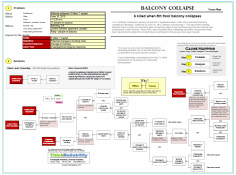By Kim Smiley
The potential danger of confined spaces is well documented, but nine fatalities have shown that people working near open hydrocarbon storage hatches can also be exposed to dangerous levels of hydrocarbon gases and oxygen-deficient atmospheres. NPR recently highlighted this issue in an article entitled “Mysterious Death Reveals Risk In Federal Oil Field Rules” that discussed the death of Dustin Bergsing. His job duties included opening the hatch on a crude oil storage tank to measure the level of the oil and was found dead next to an open hatch. He was healthy and only 21 years old.
 A Cause Map, a visual format for performing a root cause analysis, can be used to help explain what happened to cause his death. A Cause Map intuitively lays out the cause-and-effect relationships that contributed to an issue and is built by asking “why” questions. Click on “Download PDF” to view a high level Cause Map of this accident.
A Cause Map, a visual format for performing a root cause analysis, can be used to help explain what happened to cause his death. A Cause Map intuitively lays out the cause-and-effect relationships that contributed to an issue and is built by asking “why” questions. Click on “Download PDF” to view a high level Cause Map of this accident.
So why did his death occur? An autopsy showed that his death occurred because he had hydrocarbons in his blood. This occurred because he was exposed to hydrocarbon vapor and he remained in the dangerous environment. (When two causes both contribute to an effect, they are listed vertically on the Cause Map and separated by an “and”.)
When a person is exposed to hydrocarbon vapor, they get disoriented before passing out so it is very difficult for them to get to safety on their own. Bergsing was working alone at the time of his death and no one was aware that he was in trouble before it was too late.
He was exposed to hydrocarbon gases because he opened a hatch on a crude oil storage tank and the gas had collected at the top of the tank. He opened the hatch because he planned to manually measure the tank level by dropping a rope inside. Manual tank measurement is a common method to determine level in crude oil storage tanks. Crude oil contains volatile hydrocarbons that can bubble out of the crude oil and collect at the top; the gas will rush out of the tank if a hatch is opened.
Additionally, he wasn’t wearing adequate PPE equipment because it wasn’t required by any regulations and there was limited awareness of this danger.
After his and the other deaths, the industry is starting to become more aware of this issue. The National Institute for Occupational Safety and Health (NIOSH) and the Occupational Safety and Health Administration (OSHA) issued a hazard alert bulletin that identified health and safety risks to workers who manually gauge or sample fluids on production and flowback tanks from exposure to hydrocarbon gases and vapors and exposure to oxygen-deficient atmospheres. In addition to working to raise awareness of the issue, OSHA and NIOSH made recommendations to improve working safety that include the following:
– Implementing alternate procedures that allow workers to monitor tank levels and sample without opening hatches
– Installing hatch pressure indicators
– Conducting worker exposure assessments
– Providing training on the hazard and posting hazard signage
– Not permitting employees to work alone
Please read the OSHA and NIOSH hazard alert bulletin for more information and a full list of the recommendations. Many of the recommendations would be expensive and time-consuming to implement, but some may be relatively simple ways to reduce risk. Continuing to provide information to workers about the potential hazards might be a good first step to improve their safety.









